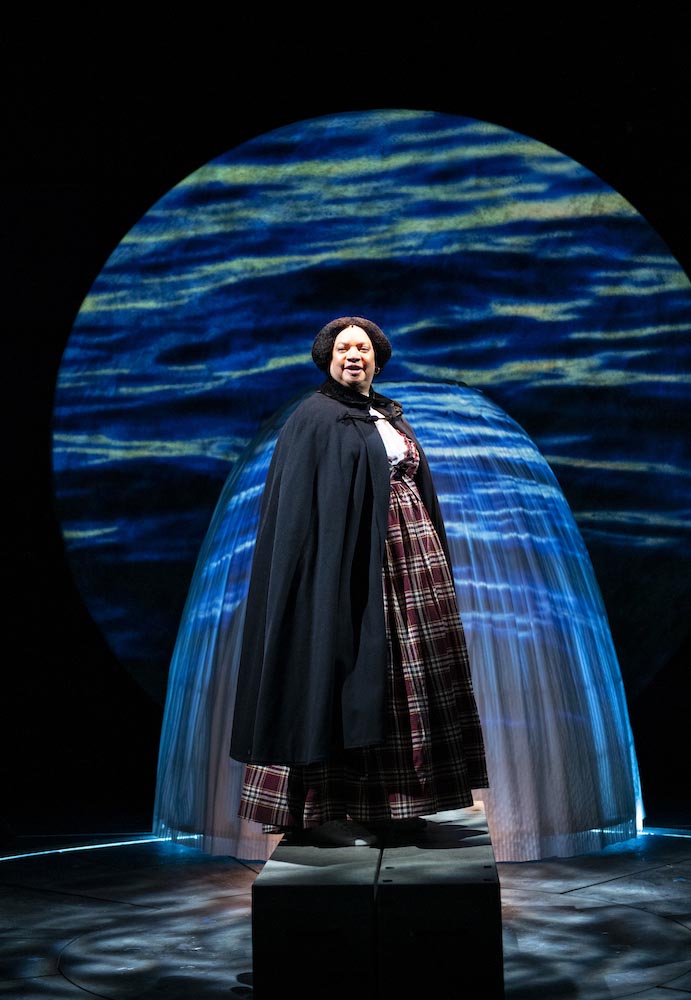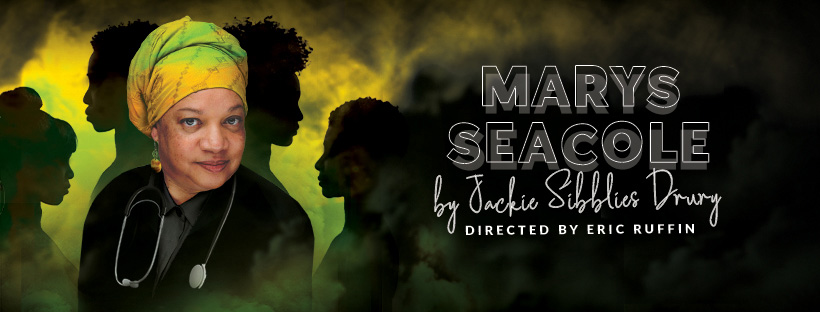Jackie Sibblies Drury is one of a new generation of African American playwrights who have become a revolutionary force.
In 2019, Woolly presented Drury’s Fairview, which won the Pulitzer Prize for Drama that year. In conjunction with Fairview, Woolly produced a show by the Harlem-based Movement Theatre Company that is specifically by, about, and for Black people. What to Send Up When It Goes Down, by Aleshea Harris, addressed racialized violence. At Mosaic, Dear Mapel, by Psalmayene 24, was streaming in February of this year. A Strange Loop, the Pulitzer Prize–winning musical with book, music, and lyrics by Michael R. Jackson, had a successful run at Woolly Mammoth and recently opened on Broadway.
Mosaic, under the leadership of Artistic Director Reginald L. Douglas, is now producing Marys Seacole, a new play by Drury, which is part of this groundbreaking cultural explosion. Directed by Eric Ruffin (Mosaic’s Fabulation, 2019) and featuring an all-female ensemble cast led by DC favorite Kim Bey and Broadway star Tina Fabrique, Marys Seacole explores the life of an extraordinary woman and the role of the caregiver throughout the centuries.

Mary Seacole’s story is an inspiring one. She was British-Jamaican, born in Kingston in 1805. She was saintly but practical, at times nurse, at times businesswoman, at times entrepreneur. She made her way ultimately to the Crimean War, where she set up a “British hotel” for the comfort of the soldiers.
Working on the front lines, sometimes under fire, she took care of all who needed her, especially the wounded and dying, whom she referred to as her “sons.” She was awarded the Jamaican Order of Merit in 1991. In 2004, she was voted the greatest Black Briton. Her autobiography, Wonderful Adventures of Mrs. Seacole in Many Lands (1857), is one of the earliest autobiographies of an Afro-Caribbean woman.
The play has many resonances for today: the scourge of racism, and the importance of caregivers, who often nurse patients who are far from loved ones. The role of the mother, in all its contradictions, became so much more difficult during the pandemic. And the site of the war that made Seacole famous? Ukraine.
Although Drury cites as influences Harold Pinter, Samuel Beckett, Bertolt Brecht, and Suzan-Lori Parks (an established Black playwright whose White Noise was produced at Studio Theatre in January), the style of Marys Seacole seems more like magic realism. We see Mary in various incarnations, as a nurse in Crimea, as an aide in a modern old-age facility, and as a nanny watching a child in contemporary Manhattan. She becomes the radiant soul of caregiving. At times the original Mary comes alive in the Mary of today. Marys Seacole moves through space and time, with women playing a number of different roles.
Director Eric Ruffin has assembled an outstanding cast. Kim Bey is Mary; Tina Fabrique is the mysterious Duppy Mary. Amanda Morris Hunt is Mamie, whom Mary attempts to instruct, in various settings, about the vicissitudes of nursing and of life. Their interactions are pitch-perfect and often very funny.

Megan Graves is Miriam, who is at times a grandchild visiting her grandmother in a nursing home, a young mother in Manhattan, and a volunteer pretending to be pregnant in an exercise to teach nurses about triage in mass-casualty shootings.
Tonya Beckman (May) is Florence Nightingale, a demanding Englishwoman in Kingston, and the mother of Graves’ “pregnant” volunteer. Claire Schoonover is a desperately ill nursing home patient, a nun in the Crimea, and the shooter in the triage scenario.
Toward the end, it seems, we are welcomed into the mind of Mary in her various incarnations. Duppy Mary (Tina Fabrique) brilliantly reminds us of the horrors of American racism with a tale that, though poetically beautiful, is sadly a surprise to no one. (The white characters have also been written as sometimes annoying and/or racist.)

Director Eric Ruffin has devoted exceptional attention and care to each element of the production. At times the story is a bit hard to follow, and the pace slow; but that flaw is more than compensated for by the prodigious talents of the participants.
The set by Emily Lotz, properties by Deborah Thomas, costumes by Moyenda Kulemeka, and sound design by Cresent Haynes all draw heavily on Jamaican culture. Lighting designer is John D. Alexander and projections design is by Mona Kasra.
These words of Mary Seacole summarize her mission:
I am not ashamed to confess that I love to be of service to those who need a woman’s help and wherever the need arises—on whatever distant shore—I ask no greater or higher privilege than to minister to it.
It is now our privilege to honor her.
Running Time: One hour 40 minutes, with no intermission.
Marys Seacole plays through May 29, 2022, presented by Mosaic Theater Company performing in the Sprenger Theatre at Atlas Performing Arts Center, 1333 H Street NE, Washington DC. For tickets ($68 general admission), call the box office at (202) 399-7993 ext. 2, or go online.
Open-captioned performances are May 21 at 3 PM, May 21 at 8 PM, May 26 at AM, and May 26 at 8 PM (includes ASL postshow).
The Marys Seacole program is online here.
COVID Safety: All patrons, visitors, and staff who visit the Atlas Performing Arts Center are required to provide proof of vaccination to be admitted into the venue. Face masks that cover the nose and mouth are required to be worn at all times regardless of vaccination status while inside the building. See Mosaic Theater Company’s complete COVID Safety policies and procedures.
MARYS SEACOLE
Written by Jackie Sibblies Drury
Directed by Eric Ruffin
CAST
May: Tonya Beckman
Mary: Kim Bey
Duppy Mary: Tina Fabrique
Miriam: Megan Graves
Mamie: Amanda Morris Hunt
Merry: Claire Schoonover
PRODUCTION
Scenic Designer: Emily Lotz
Lighting Designer: John D. Alexander
Projections Designer: Mona Kasra
Costume and Wig Designer: Moyenda Kulemeka
Sound Designer: Cresent Haynes
Props Designer: Deb Thomas
Intimacy and Fight Consultant: Sierra Young
Dramaturg: Teisha Duncan
Dialect Coaches: Teisha Duncan and Jen Rabbitt Ring
SEE ALSO:
‘I want to give you goosebumps when you’re at Mosaic’: Reginald L. Douglas (interview by Ramona Harper)
Mosaic announces its next chapter with powerful 2022/23 lineup (season announcement)






This is an excellent review of a difficult play.
This review carefully fills itself out with detail about other plays, history and commentary about race etc in order, it seems to this reader, to avoid the elephant in the room. This play is awful. The actors did their best with a confused and confusing piece that is very hard to understand and poorly directed. I hated it.